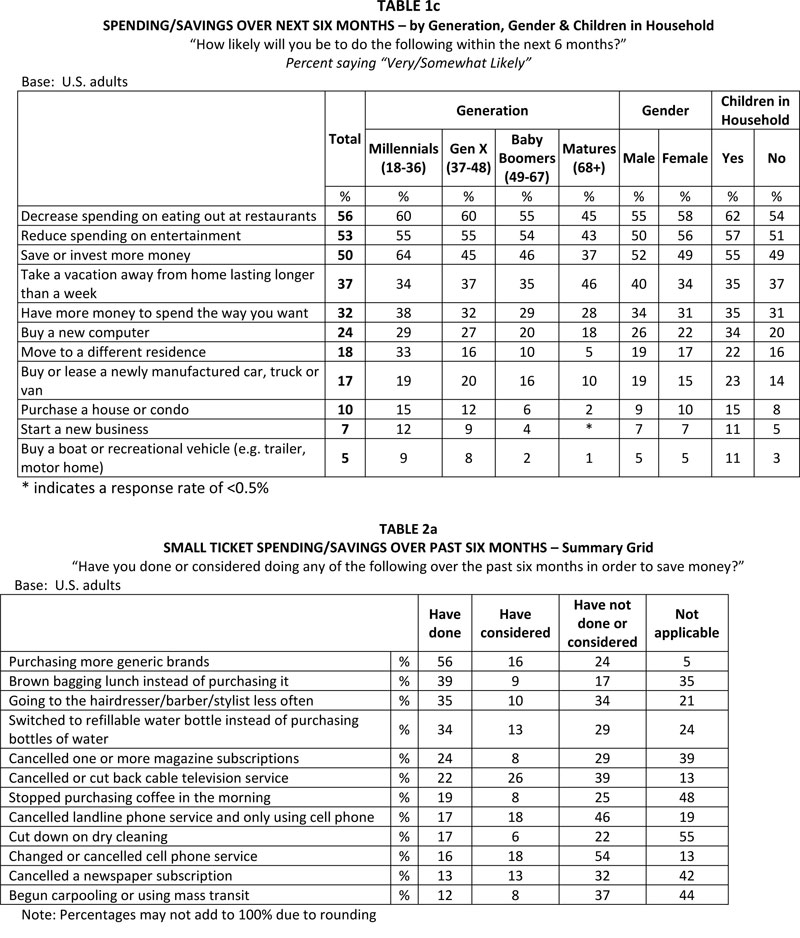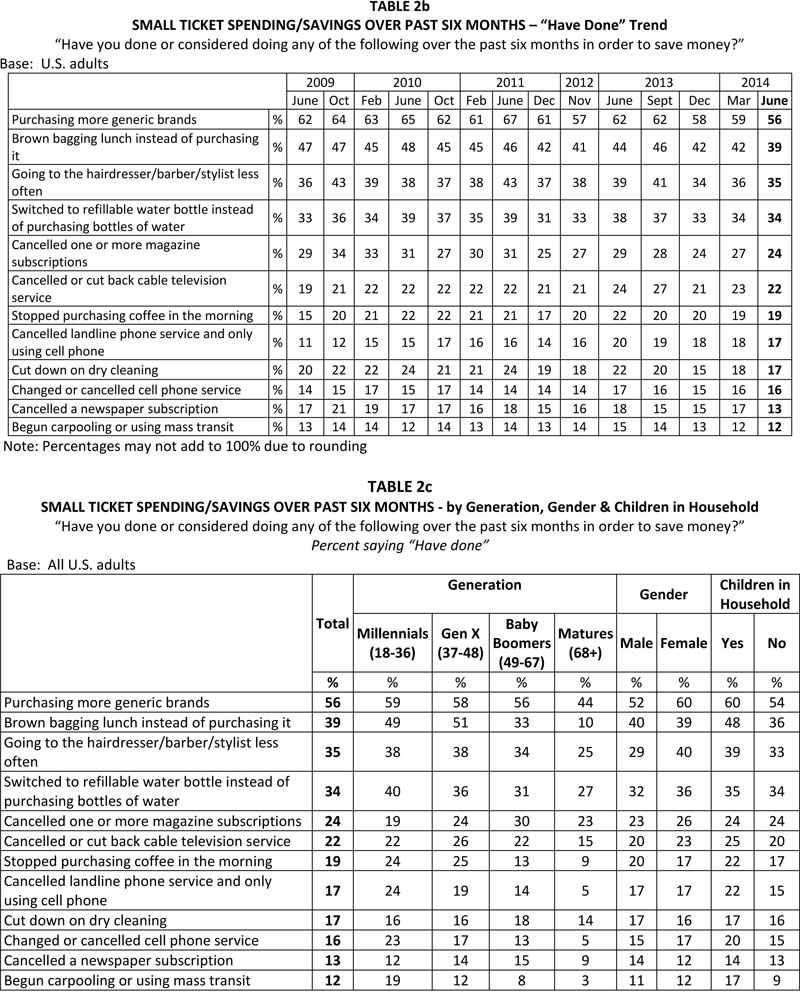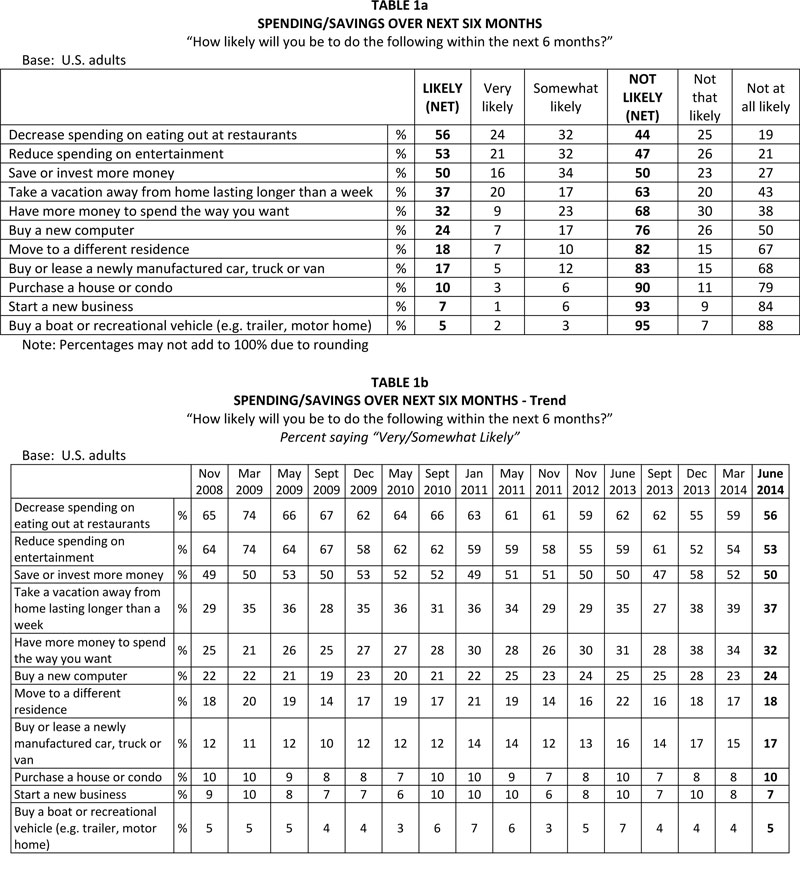Spending & Saving Trends signal Rising Confidence
July 5, 2014
 At 2014’s halfway point, Americans are loosening their purse strings in several key areas, backing off of several key efficiencies and cutbacks in comparison to a year ago, indicating Americans may be a bit more confident in their financial prospects for the near future. Looking further back, American financial attitudes continue to show great improvement over a few years ago.
At 2014’s halfway point, Americans are loosening their purse strings in several key areas, backing off of several key efficiencies and cutbacks in comparison to a year ago, indicating Americans may be a bit more confident in their financial prospects for the near future. Looking further back, American financial attitudes continue to show great improvement over a few years ago.
Dinner and a movie
Americans are less likely than a year ago to say that they plan on decreasing their spending on eating out at restaurants within the next six months (56%, down 6 points), along with being a bit less likely to say this than in March (down 3 points). U.S. adults are also less likely than a year ago to say they’ll reduce spending on entertainment (53%, down 6 points).
The picture isn’t entirely rosy though – for better or worse, Americans show no year-over-year change in their likelihood to say they’ll save or invest more money in the next six months (unchanged at 50%) or that they’ll have more money to spend the way they want (32%, up 1 point).
Women are more likely than men to anticipate cutting back on entertainment spending (56% vs. 50%); on the more free-spending end of the spectrum, men are more likely than women to anticipate taking a vacation away from home lasting longer than a week (40% vs. 34%).
Looking at things generationally, younger Americans are more likely to anticipate both cutting back and spending big. Echo Boomers, Gen Xers and Baby Boomers are all more likely than Matures to indicate they plan both restaurant (60%, 60% and 55% vs. 45%) and entertainment (55%, 55% and 54% vs. 43%) cutbacks, while Millennials are more likely than any other generation to indicate they plan on saving or investing more money (64% vs. 45%, 46% and 37%).
On the other hand, Millennials (38%) are also more likely than Baby Boomers or Matures (29% and 28%) to indicate they expect to have more money to spend they way they want in the next six months. Additionally, Millennials and Gen Xers (15% and 12%) are more likely than Baby Boomers or Matures (6% and 2%) to anticipate buying a house or condo within that time.
Daily/monthly “small ticket” spending cutbacks also down vs. a year ago
When asked to look back at cutbacks they’ve instituted over the past six months to save money, fewer Americans are cutting back on common daily and monthly expenditures in comparison to a year ago.
Some key decreases in such behaviors include fewer Americans saying they’re purchasing more generic brands (56%, down 6 points) and are brown bagging lunch instead of purchasing it (39%, down 5 points), along with fewer saying they’ve cancelled magazine (24%, down 5 points) or newspaper (13%, down 5 points) subscriptions and that they’ve cut down on dry cleaning (17%, down 5 points). As for making fewer trips to the hairdresser, stylist or barber, 35% of Americans indicate this sort of cutback – a decrease of 4 points from a year ago.
Women are more likely than men to say they’re purchasing more generic brands (60% vs. 52%) and that they’re going to the hairdresser, barber or stylist less often (40% vs. 29%).
Those with children in the household are more likely than those without to indicate brown bagging lunch (48% vs. 36%), cancelling landline phone service (22% and 15%), changing or cancelling cell phone service (20% vs. 15%) and that they’ve begun carpooling or using mass transit (17% vs. 9%).































